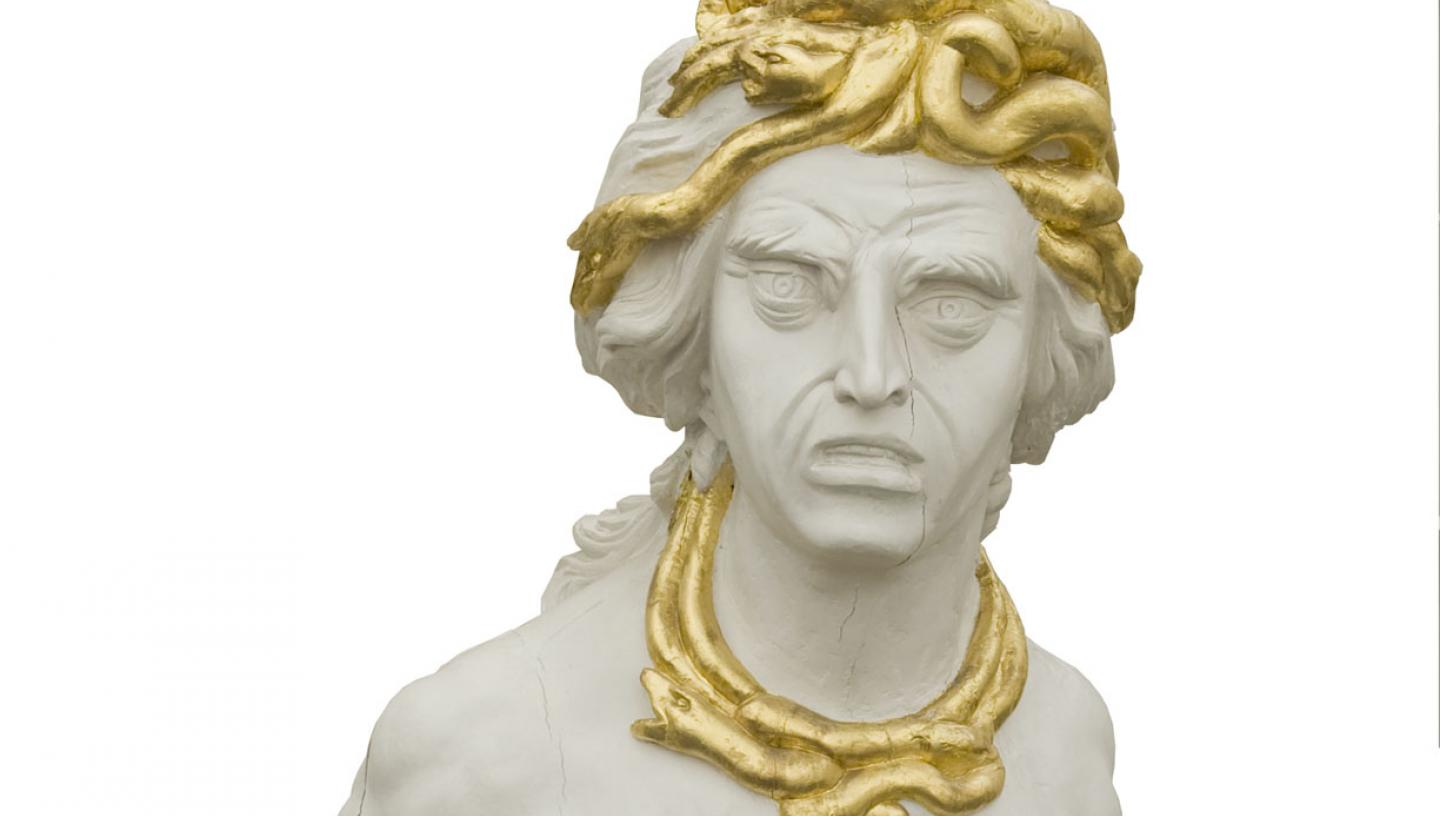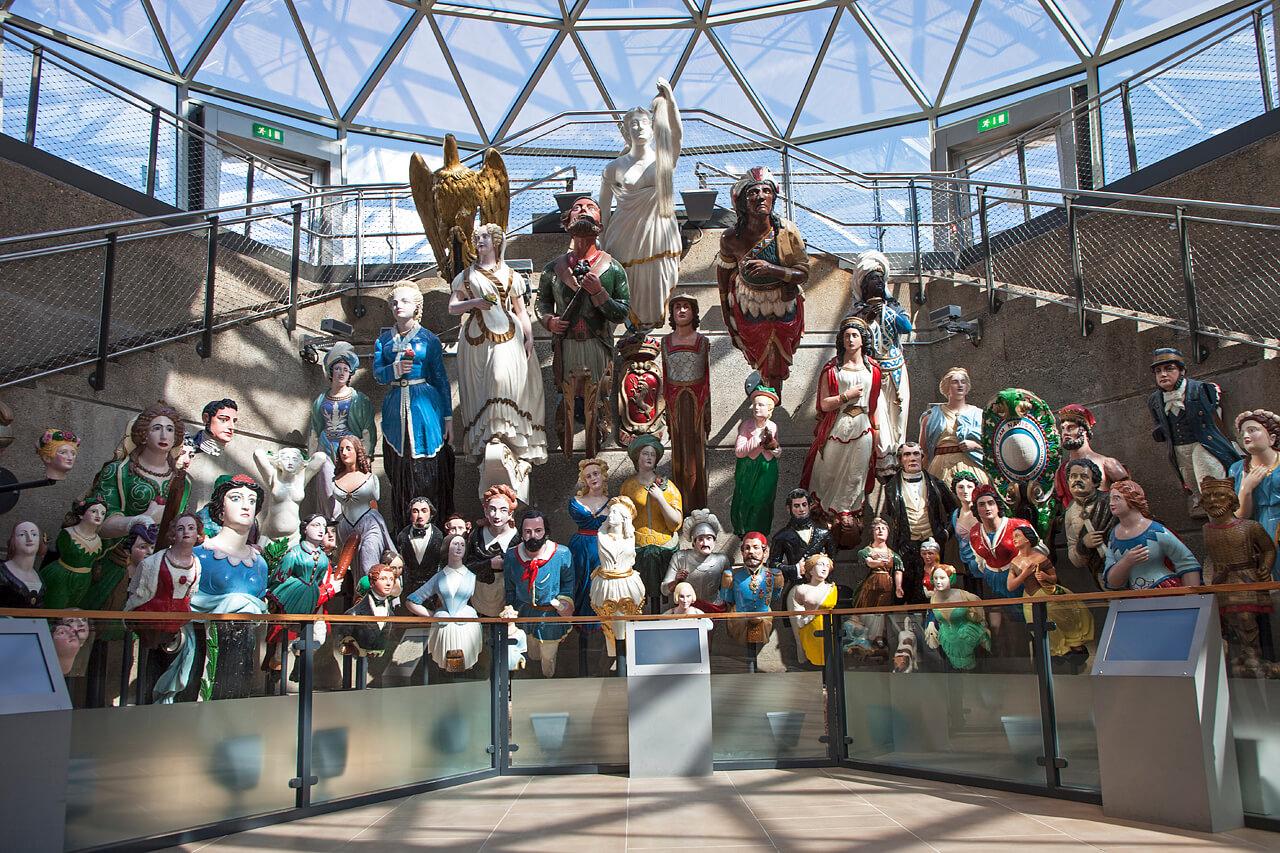
Cutty Sark is home to the largest collection of Merchant Navy figureheads in the world.
Our collection of ship figureheads and carving traces the history of ship ornamentation from the 17th to the 20th centuries.
What is a figurehead?
Figureheads are the carved wooden sculptures that decorate the prows of sailing ships. In the perilous life of an ocean-going ship, figureheads embodied the spirit of the vessel, offering the crew protection from harsh seas and safeguarding their homeward journeys.
As such, they were often lovingly cared for by the crew. The superstitions of seamen meant that the figurehead held great significance to those on board and they would go to great lengths to protect it.
Figureheads were often female but not exclusively so. A female may have been popular because the ship itself is always referred to as a ‘she’. As women were often not allowed on board, the figurehead itself might also represent the sole female on the ship.

Choosing the figurehead
But a range of subjects were chosen for the figureheads of merchant vessels. Very often, they were portraits of a member of the ship-owner’s family, or even the owner himself. Alternatively the owner may have chosen a figure from history or an influential individual from contemporary society. By choosing a heroic or favourable person to adorn their ship, merchant ship owners hoped other merchants would associate their heroicism with their shipping company.
To the crew, the figureheads were seen as lucky charms, representing not only the eyes of the ship guiding them safely home but also the spirit of the vessel as well.
The history of figureheads
The origins of the figurehead and other forms of ship decoration goes back thousands of years. The decoration and carving of vessels was common among seafaring civilisations of the ancient world, with evidence of Egyptian figureheads dating back to around 3000 BC.
The precise motive behind mounting a carved figurehead at the bow of a ship or boat is uncertain. It is believed these iconic objects held a strong magical or religious significance relating to a ship 'seeing' its way safely through the sea.
By around 1700, the decoration of naval vessels had reached its peak and the Royal Navy began the process of restricting ornamental carving around the bow and stern. Decoration on lower-ranking warships was curtailed in this period, while dispensations were sought for first-rate and second-rate vessels.
The advent of clipper ships around 1850 prompted a revival of the figurehead and allowed the fitting of a full-length figure at the bow.
How were figureheads made?
Elm or oak was used for figureheads up to the 18th century, but after this time alternative woods were used as the heavy, hard woods were found to impact on the seaworthiness of the vessels. Yellow pine was a popular choice of material – in essence the carver needed light and durable woods, but it needed to be timber that was least prone to rotting given the constant exposure to water.
A solid block of wood was chosen, or if a very large figure, then several large pieces of timber would be dowelled and glued together. A sketch of the figurehead may be made by the carver or the shipbuilder, but the exact design would be dictated by the size of the ship and the rake of the bow. Chisels, mallets, gouges and sandpaper would be used and the eventual cost of the work depended on amount of labour involved – some figureheads could take weeks, some months.
Long John Silver Collection
At Cutty Sark, the collection is gathered like a colourful choir at the north end of the gallery, positioned directly under the bow of ship.
The collection is named after the donor Sydney Cumbers who, thanks to his love of all things maritime and the eye-patch he wore, assumed the pseudonym of Captain Long John Silver. Sydney Cumbers was, by all accounts, an eccentric character himself and took on the alter-ego of Long John Silver in his private museum, ‘The Look-Out’ in Gravesend, Kent. Fondly referring to his wife as ‘The Mate’, the Look-Out was home to Cumbers’ extensive collection of memorabilia.
He displayed models and paintings as well as curios collected by seamen on their travels. The Look-Out was undoubtedly dominated by this extensive figurehead collection – one of the largest collections in the world. Mostly dating from the 19th century, these figureheads all came from merchant vessels, many of which shared the oceans with Cutty Sark.
Sydney Cumbers had watched Cutty Sark being towed up to Greenhithe in 1938 when the ship joined the Incorporated Thames Nautical Training College, and when he heard in 1953 that Cutty Sark was coming to Greenwich to become a public attraction and memorial to the Merchant Navy, he offered to donate his collection.
Following the Cutty Sark Conservation Project, the figureheads are prominently displayed in the Sammy Ofer Gallery, under the bow of Cutty Sark with her figurehead, Nannie.
Sydney Cumbers had dedicated his figurehead collection to the Merchant Seaman of Britain, and in this way these figureheads, from vessels now lost or broken up, support Cutty Sark’s memorial role to those in the Merchant Navy.
Among the figureheads in the Long John Silver collection are a vast range of characters from literature, legend, history and politics which we will explore in a series of blogs over the coming weeks. Visitors will notice however that for half of the collection, the names, namesakes and stories are a mystery to us as they were lost to obscurity when the vessels they once adorned were wrecked or broken up.
Visit the Long John Silver Collection
Using our collections for research
Nearly two-thirds of our collection was acquired from the Admiralty between the 1930s and 1970s. As a result, our collections are particularly strong for studying naval figureheads from various classes of warship.
The Museum also holds the figurehead from Nelson's funeral carriage, plus some fine figureheads and carvings from merchant vessels. The ‘Valhalla’ collection on Tresco, Isles of Scilly, is a particularly fine group for visitors there, which has belonged to Museum since 1979.
Our excellent ship model collection also gives an indication of the scale and scope of decoration on earlier vessels, especially those from the 18th century.
Using our collections for research